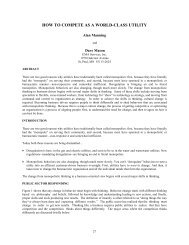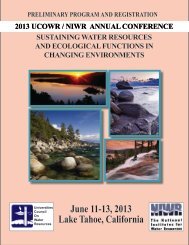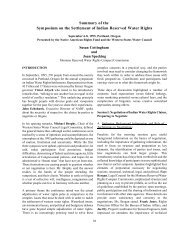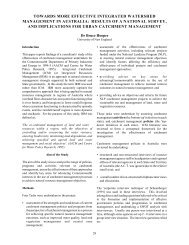82Barreira<strong>and</strong> ground water. To this end, the directive obligesmember states to prevent further deterioration<strong>and</strong> to enhance <strong>and</strong> restore the status <strong>of</strong> aquaticecosystems. The most important result <strong>of</strong> itsimplementation will be the achievement <strong>of</strong> the goodstatus <strong>of</strong> waters by 2015. This goal is translatedinto environmental objectives for surface waters(good ecological <strong>and</strong> chemical status), groundwater (good quantitative <strong>and</strong> chemical status) <strong>and</strong>to protected areas (compliance with st<strong>and</strong>ards<strong>and</strong> objectives specified in community legislationestablishing those areas). The environmentalobjectives are to be achieved with the development<strong>and</strong> implementation <strong>of</strong> river basin managementplans <strong>and</strong> <strong>of</strong> programs <strong>of</strong> measures. It alsoprovides specific obligations on active <strong>and</strong> realpublic participation in the preparation, review. <strong>and</strong>updating <strong>of</strong> the river basin management plans formember states. In accordance with some initiativesto give specific weight to economic instrumentsin environmental policy, the <strong>Water</strong> FrameworkDirective fosters the use <strong>of</strong> water-pricing policiesto motivate its sustainable use <strong>and</strong> recover the cost<strong>of</strong> water services 10 . Table 1 shows the key elements<strong>of</strong> the <strong>Water</strong> Framework Directive.The Environmental ObjectiveThe environmental objectives that insist onthe achievement <strong>of</strong> a good <strong>and</strong> non-deterioratingstatus for all bodies <strong>of</strong> waters (surface <strong>and</strong> groundwater) are legally binding. There are a number <strong>of</strong>objectives for protecting water quality. The keyones at the European level are general protection<strong>of</strong> aquatic ecology, specific protection <strong>of</strong> unique<strong>and</strong> valuable habitats, protection <strong>of</strong> drinking waterresources, <strong>and</strong> protection <strong>of</strong> bathing water. Allthese objectives must be integrated for each riverbasin. It is clear that the last three—special habitats,drinking water areas <strong>and</strong> bathing water—applyonly to specific bodies <strong>of</strong> water (those supportingspecial wetl<strong>and</strong>s; those identified for drinkingwater abstraction; <strong>and</strong> those generally used asbathing areas). In contrast, ecological protectionshould apply to all waters: the central requirement<strong>of</strong> the treaty is that the environment in its entiretybe protected to a high level.For surface waters, good status is determined bya good ecological <strong>and</strong> chemical status. The ecologicalstatus is determined by biological, hydro-morphological<strong>and</strong> physico-chemical quality elements.The chemical status requires the reduction <strong>of</strong> thepresence <strong>of</strong> priority substances <strong>and</strong> the elimination<strong>of</strong> priority hazardous substances by 22 December2020. In the case <strong>of</strong> bodies <strong>of</strong> water designated asartificial <strong>and</strong> heavily modified, member states shallprevent deterioration <strong>and</strong> shall protect <strong>and</strong> enhancethem with the aim <strong>of</strong> achieving good ecologicalpotential <strong>and</strong> good surface water chemical statusby December 2015.For ground water, good status is determinedby its quantitative status <strong>and</strong> its chemical status.Nevertheless, Article 4 <strong>of</strong> the <strong>Water</strong> FrameworkDirective also provides for certain exceptions tothe binding environmental objectives when all theconditions that it specifies are met (see Table 2).One <strong>of</strong> the innovations <strong>of</strong> the directive is that itprovides a framework for integrated management<strong>of</strong> ground <strong>and</strong> surface water for the first time at theEuropean level.Institutional Structure: River BasinAuthorities <strong>and</strong> PlansOne <strong>of</strong> the important concepts <strong>of</strong> the <strong>Water</strong>Framework Directive is the organization <strong>and</strong>regulation <strong>of</strong> water management at the level<strong>of</strong> river basins, taking into account the naturalgeographical <strong>and</strong> hydrological unit, instead <strong>of</strong>using administrative or political boundaries. Tothis effect, river basin districts are the managementunits comprising the area <strong>of</strong> l<strong>and</strong> <strong>and</strong> sea, made upTable 1. Key Elements <strong>of</strong> the European <strong>Water</strong> Framework Directive.••••••protecting all waters, surface <strong>and</strong> ground waters in a holistic waygood quality (“good status”) to be achieved by 2015integrated water management based on river basinscombined approach <strong>of</strong> emission controls <strong>and</strong> water quality st<strong>and</strong>ards, plus phasing out <strong>of</strong> particularlyhazardous substanceseconomic instruments: economic analysis, <strong>and</strong> getting the prices right to promote prudent use <strong>of</strong> watergetting citizens <strong>and</strong> stakeholders involved: public participationUCOWRJOURNAL OF CONTEMPORARY WATER RESEARCH & EDUCATION
<strong>Water</strong> Governance at the European Union83Table 2. Environmental objectives <strong>and</strong> exemptions <strong>of</strong> the European <strong>Water</strong> Framework Directive.The main environmental objectives in the directive are manifold <strong>and</strong> include the following elements (for detailssee Article 4 para. 1, (a) surface waters, (b) ground waters <strong>and</strong> (c) protected areas):•••••No deterioration <strong>of</strong> status for surface <strong>and</strong> ground waters <strong>and</strong> the protection, enhancement, <strong>and</strong> restoration<strong>of</strong> all water bodiesAchievement <strong>of</strong> good status by 2015, i.e. good ecological status (or potential) <strong>and</strong> good chemical status forsurface waters <strong>and</strong> good chemical <strong>and</strong> good quantitative status for ground watersProgressive reduction <strong>of</strong> pollution <strong>of</strong> priority substances <strong>and</strong> phase-out <strong>of</strong> priority hazardous substancesin surface waters <strong>and</strong> prevention <strong>and</strong> limitation <strong>of</strong> input <strong>of</strong> pollutants in ground watersReversal <strong>of</strong> any significant, upward trend <strong>of</strong> pollutants in ground watersAchievement <strong>of</strong> st<strong>and</strong>ards <strong>and</strong> objectives set for protected areas in Community legislationIt is important to note that where more than one <strong>of</strong> the objectives relates to a given body <strong>of</strong> water, the moststringent shall apply (Art. 4,2), irrespective <strong>of</strong> the fact that all objectives must be achieved.In order to achieve the specific objectives for heavily modified <strong>and</strong> artificial water bodies (i.e. good ecologicalpotential <strong>and</strong> good chemical status), the provisions for designation (see Article 4, 3), contain elements <strong>of</strong>comparing the consequences <strong>of</strong> achieving the “good ecological status” to a number <strong>of</strong> aspects including economicconsiderations. Moreover, the assessment <strong>of</strong> “good ecological potential” is linked to the possible mitigationmeasures.An integral part <strong>of</strong> the environmental objectives set out in Article 4 are the so-called exemptions. Theseexemptions range from small scale temporary exemptions to mid- <strong>and</strong> long-term deviations from the rule “goodstatus by 2015,” <strong>and</strong> include the following aspects:••••Extension <strong>of</strong> the deadline by two times six years, in other words, good status must be achieved by 2027 atthe latest (Article 4,4)Achievement <strong>of</strong> less stringent objectives under certain conditions (Article 4,5)Temporary deterioration <strong>of</strong> the objectives in case <strong>of</strong> natural causes or “force majeur” (Article 4,6)New modifications to the physical characteristics <strong>of</strong> a surface water body or alterations to the level <strong>of</strong>bodies <strong>of</strong> ground water, or failure to prevent status deterioration <strong>of</strong> a body <strong>of</strong> surface water (including fromhigh status to good status) as a result <strong>of</strong> new sustainable human development activities (Article 4,7)Common to all these exemptions are strict conditions to be met <strong>and</strong> a justification to be included in the river basinmanagement plan. Furthermore, the assessment <strong>of</strong> the socio-economic impacts including the environmental <strong>and</strong>resource costs <strong>and</strong> benefits <strong>of</strong> achieving the objectives is one key element when considering the application <strong>of</strong>any exemption.Finally, paragraphs 8 <strong>and</strong> 9 <strong>of</strong> Article 4 introduce two principles applicable to all exemptions:• first, exemptions for one water body must not compromise achievement <strong>of</strong> the environmental objectives inother water bodies• second, at least the same level <strong>of</strong> protection must be achieved as provided for by existing Community law(including those elements to be repealed)<strong>of</strong> one or more neighboring river basins, togetherwith their associated ground <strong>and</strong> coastal waters.Every decision about the use or interference withthe aquatic systems within the river basin districtshould take place in principle in an integrated <strong>and</strong>co-ordinated manner <strong>and</strong> be laid out in so-calledRiver Basin Management Plans (RBMPs). Theestablishment <strong>and</strong> operation <strong>of</strong> the river basinauthorities is the cornerstone <strong>of</strong> the implementation<strong>of</strong> the <strong>Water</strong> Framework Directive. Member statesare required to designate river basins <strong>and</strong> competentauthorities within their territory, or in co-ordinationJOURNAL OF CONTEMPORARY WATER RESEARCH & EDUCATIONUCOWR
- Page 3:
Journal of ContemporaryWater Resear
- Page 6 and 7:
2Bruce Hooperinstitutional, and tem
- Page 11 and 12:
IWRM: Governance, Best Practice, an
- Page 13 and 14:
IWRM: Defi nitions and Conceptual M
- Page 15 and 16:
IWRM: Defi nitions and Conceptual M
- Page 17 and 18:
IWRM: Defi nitions and Conceptual M
- Page 19:
IWRM: Defi nitions and Conceptual M
- Page 22 and 23:
18Cardwell. Cole, Cartwright, and M
- Page 24 and 25:
20Mostert26 water boards responsibl
- Page 26 and 27:
22MostertTable 1. Third National Wa
- Page 28 and 29:
24MostertImplementationThe ambitiou
- Page 30 and 31:
26MostertBiswas, A. K. 2004b. Respo
- Page 32 and 33:
28UNIVERSITIES COUNCIL ON WATER RES
- Page 34 and 35:
30Ashton, Turton, and Rouxresource
- Page 36 and 37: 32Ashton, Turton, and Rouxassumptio
- Page 38 and 39: 34Ashton, Turton, and RouxEffective
- Page 40 and 41: 36UNIVERSITIES COUNCIL ON WATER RES
- Page 42 and 43: 38Hussey and Doversin water policy
- Page 44 and 45: 40Hussey and Dovers1994 Council of
- Page 46 and 47: 42Hussey and Doversestablished Thes
- Page 48 and 49: 44Hussey and DoversTable 1. Typolog
- Page 50 and 51: 46Hussey and Doversassessment appro
- Page 52 and 53: 48Hussey and Doverspolicy goals.Bey
- Page 54 and 55: 50Hussey and DoversFrawley, K. 1994
- Page 56 and 57: 52Mitchelloften took three to four
- Page 58 and 59: 54Mitchelltree preservation plans;
- Page 60 and 61: 56UNIVERSITIES COUNCIL ON WATER RES
- Page 62 and 63: 58Genskow and Borna series of chall
- Page 64 and 65: 60Genskow and BornTable 1. Watershe
- Page 66 and 67: 62Genskow and Bornthe first Dungene
- Page 68 and 69: 64Genskow and BornWashington, DC.Ko
- Page 70 and 71: 66Green and Fernández-BilbaoWithin
- Page 72 and 73: 68Green and Fernández-Bilbaosubjec
- Page 74 and 75: 70Green and Fernández-Bilbaoinflue
- Page 76 and 77: 72Green and Fernández-BilbaoBerbel
- Page 78 and 79: 74UNIVERSITIES COUNCIL ON WATER RES
- Page 80 and 81: 76BallweberEstablish AdvisoryCommit
- Page 82 and 83: 78Ballweberattributes in others (Ch
- Page 84 and 85: 80UNIVERSITIES COUNCIL ON WATER RES
- Page 88 and 89: 84Barreirawith other states for int
- Page 90 and 91: 86UNIVERSITIES COUNCIL ON WATER RES
- Page 92 and 93: 88Davis and ThrelfallResource Manag
- Page 94 and 95: 90Davis and ThrelfallTable 2. Thirt
- Page 96 and 97: 92Davis and Threlfallby regional an
- Page 98 and 99: 94Davis and Threlfallenforcement, a
- Page 100 and 101: 96Davis and Threlfallhusbandry prac
- Page 102 and 103: 98Davis and ThrelfallNew Zealand: T
- Page 104 and 105: 100UNIVERSITIES COUNCIL ON WATER RE
- Page 106 and 107: 102Lamoree and van SteenbergenIt is
- Page 108 and 109: 104Lamoree and van Steenbergenand n
- Page 110 and 111: 106Lamoree and van Steenbergeninter
- Page 112 and 113: 108BourgetWorks Planner Capability
- Page 114 and 115: 110Bourgetwith over 600 people resp
- Page 116 and 117: 112Bourgetgovernment’s intrusion
- Page 118 and 119: 114Bourget4.management, drought man
- Page 120 and 121: 116McKayFigure 1. The four paradigm
- Page 122 and 123: 118McKay4. Paradigm 4 (which commen
- Page 124 and 125: 120McKaythree main functions:1. ass
- Page 126 and 127: 122McKayState Implementation of the
- Page 128 and 129: 124McKayTable 2. Corporate governan
- Page 130 and 131: 126McKayFigure 4. Qu. 26 - The ESD
- Page 132 and 133: 128McKayFigure 7. Qu.93- This organ
- Page 134 and 135: 130McKayBrundtland Report. 1987. Ou
- Page 136 and 137:
132UCOWR BOARD OF DIRECTORS/COMMITT
- Page 138 and 139:
134BENEFITS OF UCOWR MEMBERSHIPThe
- Page 140 and 141:
136Past Issues of the Journal of Co
- Page 142 and 143:
138Academic Organizations Membershi
- Page 144 and 145:
140Individual Membership Applicatio
- Page 146 and 147:
Universities Council on Water Resou
- Page 148:
Integrated Water Resources Manageme








